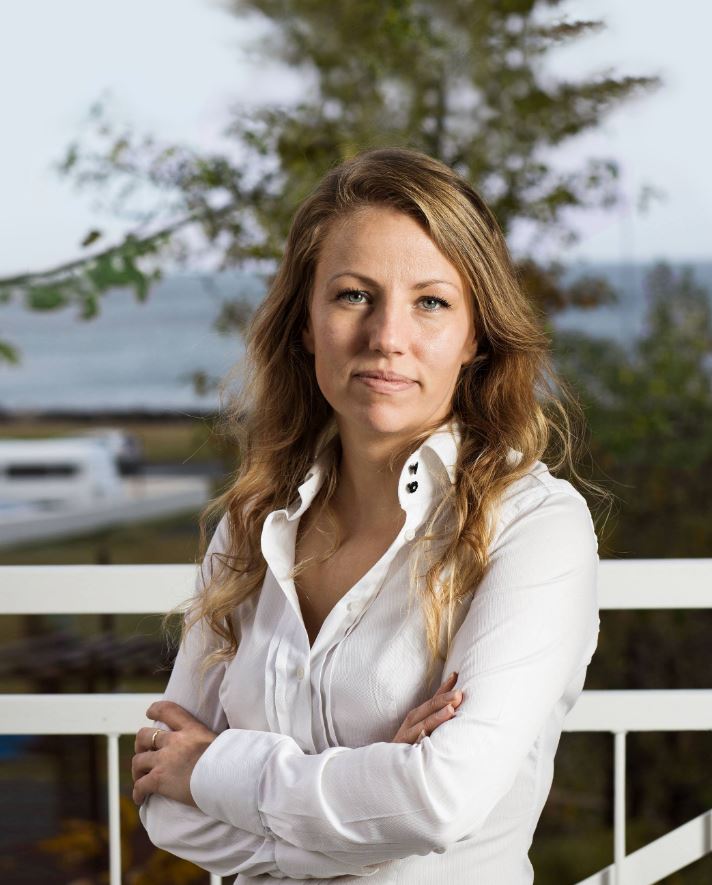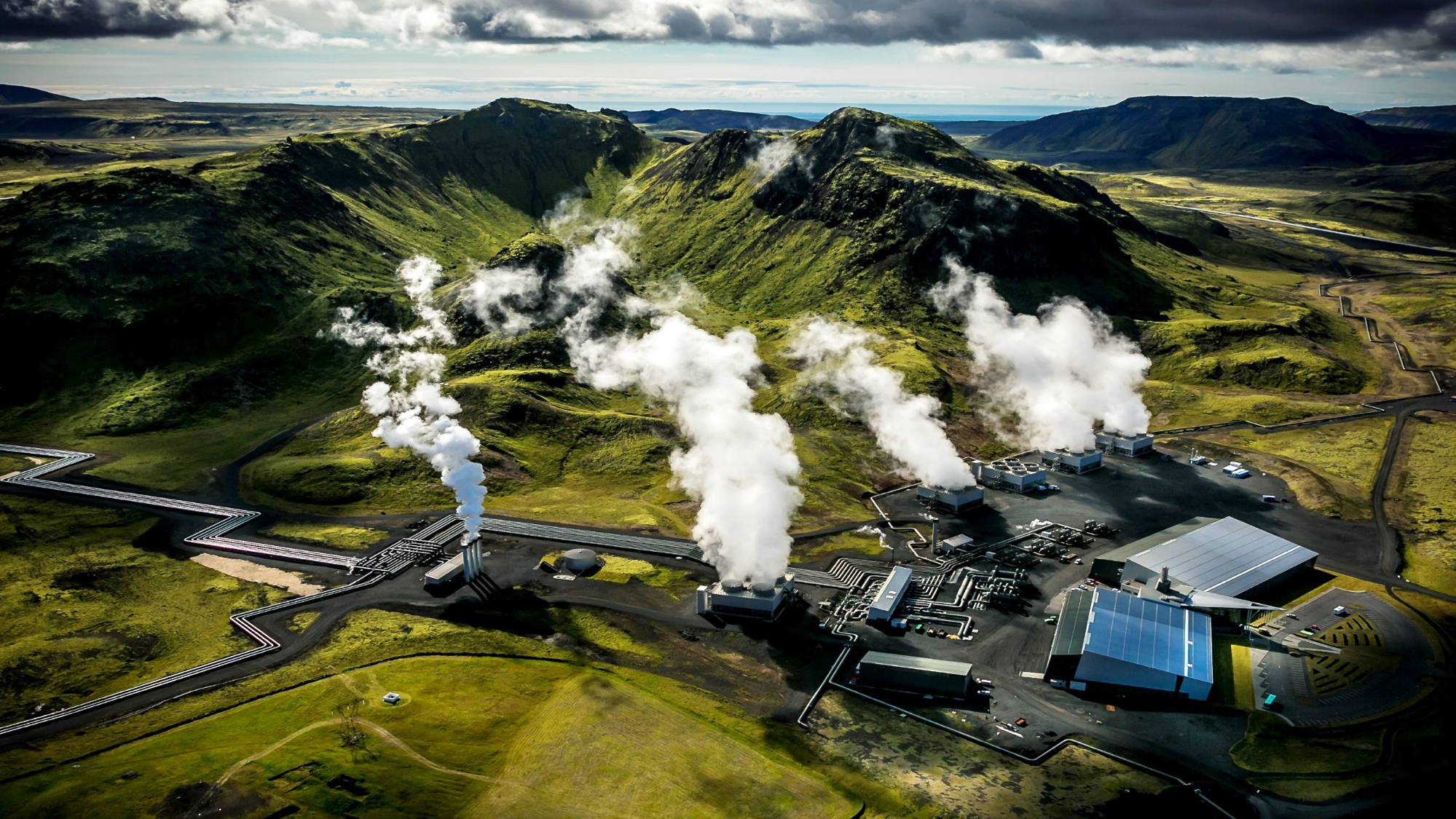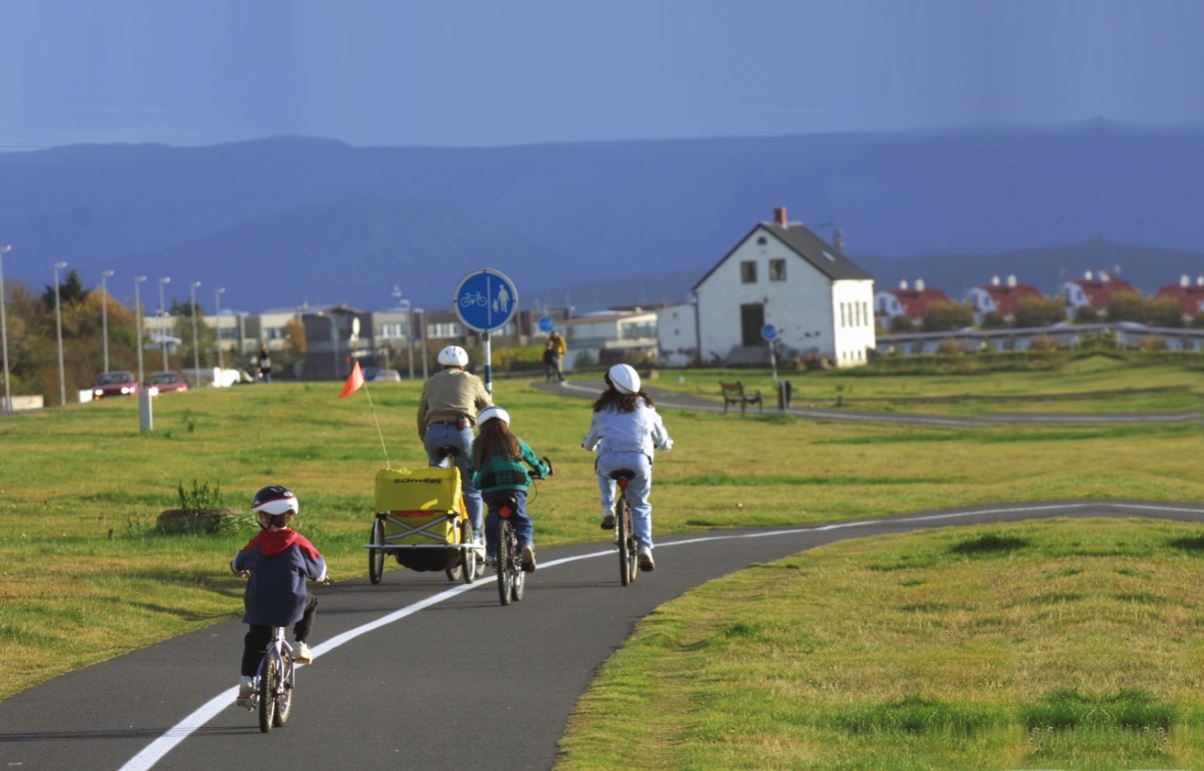
MEET WITH
Sigurborg Ósk Haraldsdóttir
Reykjavík City councillor Chairman of the Planning & Transport Committee

Off to the northernmost capital in the world, 250 km south of the Arctic Circle: an example of sustainable city.
Reykjavík is at the top of the sustainable city rankings. Remarkably, it boasts 100 % electricity supplied by renewable energy. Its secret is to be found its expanses of ice and in the bowels of its land. A new sustainable Eldorado? Not so sure, because the city, like the whole island, is facing a new energy paradox...
The successful bet of 100 % renewable electricity and heating
In the ecological category, the city with the colorful roofs lines up the trophies. Winner of the Nordic Environment and Nature Price in 2014, the capital was recently ranked 3rd in the Global Destination Sustainability index 2018. With 410 m2 of green space per inhabitant, Reykjavík has also been awarded the title of the "greenest city in the world". But it is above all another subject that attracts so much praise for this capital, home to two thirds of the island's population: That of energy.

On the Hengill volcano, the Hellisheidi geothermal power plant supplies the city of Reykjavík.
Deep in a sub-polar oceanic climate, it is important to keep in mind, that the city still manages to heat and light itself autonomously, all by using renewable energies only. A key to this is, its name, Reykjavík - literally "Bay of Smokes" - which evokes the vapours emanating from the surrounding hot springs. Iceland, situated on the Mid-Atlantic Ridge, separating the North American and Eurasian tectonic plates, has, in fact, relied heavily on the treasure that lies beneath its feet and has become a geothermal energy champion. Just a stone's throw from the capital, the Hellisheidi power station has one of the largest production capacities in the world. As a result, 97 % of the city's homes are heated by the Earth's radiation. This energy also meets 25 % of the city's electricity needs. As for the rest? The island's other treasure gets it covered: The glaciers. They cover 10 % of the country and feed the large glacial rivers punctuated by hydroelectric dams that capture the energy. However, Iceland's energy partition has a drawback: the ice caps are melting at a frenetic rate - 750 km2 since the beginning of the century - and at this rhythm, they could be wiped off the map in 300 years' time.
A textbook case
Iceland is a great example of an energy transition based on a country's own strengths. As the United Nations report points out, its approach may not apply in every context, but it can be a source of inspiration for other regions, far beyond what one might imagine. Indeed, recent volcanic activity is not a prerequisite for using geothermal energy. "In Europe alone, it is considered that approximately 25 per cent of the population lives in areas suitable for urban geothermal heating. To explore the feasibility and implementation of these and other opportunities around the world, Iceland’s know-how and experience is invaluable" concludes the report.
A matter of resilience
It is not really out of a virtuous concern for the environment that Iceland has begun its transition to renewable energy. The shift was primarily economic. The story goes back to the 1970s when oil price shocks seriously weakened the country. It is at the time that the island decided to generalise geothermal and hydroelectricity to divert from massive fossil imports. In short, it decided to draw only on its natural resources to produce its energy autonomously. A strategy that protects the island from oil price fluctuations and offers a high degree of resilience.
The benefits of geothermal energy and low-cost electricity can sometimes be inconspicuous. Under the streets of Reykjavík, the wide network of hot water pipes allows the pavements to thaw. Geothermal heat is also used in fish farming, for the production of dry algae or salt. In recent years, greenhouses have been used to produce tomatoes, salads, basil... fruits and vegetables that are very exotic in the land of the Vikings. There is even one of the largest banana plantation in Europe! Another advantage is that these crops are grown indoors, which protects them from plant diseases that circulate from one country to another.
Transportation lags behind
Committed to becoming climate neutral by 2040, it is now the subject of mobility that Reykjavík is tackling. Efforts have already been undertaken, including the gradual replacement of the bus fleet with hydrogen vehicles or incentives to encourage the purchase of electric vehicles. Numerous recharging spots are now planned, for cars but also boats! However, the modal mix is still very poor and Icelanders have difficulty using public transport or active mobility. Indeed, according to the Iceland Monitor, the country has the 2nd highest rate of car ownership per inhabitant in Europe. Reykjavík has made the matter its priority. Its plan stipulates that by 2030, its inhabitants will walk or cycle for 30 % of their journeys and use public transport for 12 % - compared to the only 4 % at present. But the pace of action is sometimes slow, and this proactive policy is sometimes difficult to implement.

Iceland, a victim of its success?
Paradoxically, the country is not on track to meet the commitments it made at the COP21. It may even figure among the lowest performers for meeting their targets all despite an opt-out clause linked to its particular energy mix. This is due not only to the carbon-intensive transport but also to the emissions from growing industrial activities and rampant tourism.
Ironically, more and more tourists, attracted by the wide angle of its nature and the country's reputation for being environmentally friendly, are driving their 4WDs along Iceland's roads. In 2018, 2.3 million people visited the island, for a population of 360,000. Except for 2019 marked by the bankruptcy of the low-cost airline WOW and the ensuing surge in ticket sales, this craze is growing every year. While this boom contributes strongly to the country's economy (42 % of export revenues in 2017), the population increasingly sees it as a threat to its ecosystems rather than a windfall. Thus, according to a survey by the Icelandic Tourist Board (2018), 75 % of Icelanders consider that the impact of tourism is too significant on nature and the government has announced restrictive measures in order to limit this influx.
In addition to tourists, the country's green card also has attracted many companies and has become a major economic asset. With very low-cost energy and a favorable carbon balance, energy-intensive industries have understood the benefits of setting up in Iceland. In particular, the country has welcomed the giants of aluminium and silica production, which are very demanding in terms of electricity. This widespread influx is exerting unprecedented pressure on the energy demand, with the industry accounting for 87 % of the local electricity production (OECD, 2015). While the use of 100 % renewable energy is certainly a major response, the aluminium industry's production processes still emit GHGs (CO2 and perfluorocarbons). Therefore, at a global scale, we are witnessing a drastic reduction in emissions from these industries. But it is de facto Iceland that is inheriting the non-negligible residues of these relocated emissions. According to the OECD, industrial processes account for 35 % of Iceland national GHG emissions, i.e. the main source of emissions ahead of transport.
Today, a new generation of companies is settling on the island. It is now opening its doors to IT and data centre players, more and more of whom want to host their data freshly, at low cost and thus economically and ecologically more advantageously. As a result of this influx, major hydroelectric and geothermal dams, including very deep geothermal tests, are multiplying to the great displeasure of environmental associations pointing out the magnitude of the damage caused to the environment. Hydrogen sulphide emissions, discharges of harmful substances into surface waters, slight land subsidence linked to power plants, and destruction of ecosystems around dams are all growing concerns in the country.
Today, Iceland is facing the paradox of its green transition. Faced with the discontent of many inhabitants and emissions that are increasing, Iceland must therefore adapt its public and industrial policies and consider new solutions.
Not far from Reykjavík, the carbon is petrified
In this race against emissions, researchers are working close to the capital, in the heights of the Hengill volcano. The idea? Accelerate the mineralisation of carbon dioxide. By trapping it and injecting it at a depth of more than 1,000 metres into the basalt where it solidifies itself into rock. In the space of two years, scientists are thus able to reproduce a natural phenomenon that normally extends over millennia. Of course, this new sequestration technique, being still in the pilot stage, still presents challenges, particularly in view of the excessive consumption of fresh water it requires. It is, however, a potential solution that is being closely monitored by IPCC scientists. Indeed, they now include geoengineering solutions in their scenarios. This is necessary, they explain, in order to stay below 1.5°C of global warming. Experiments to be continued...

MEET WITH
Reykjavík City councillor Chairman of the Planning & Transport Committee

MEET WITH
Reykjavík City councillor Chairman of the Planning & Transport Committee
The head of the Transport Committee strongly advocates green and shared mobility. Her aim is to invest massively in new networks of cycle paths and fast public transport systems. An ambition that is currently tinged with frustration…
Sustainability MAG: Climate neutral Reykjavík is for 2040. What are the priorities of your energy transition policy?
Sigurborg Ósk Haraldsdóttir: Currently, Reykjavík's climate action plan is under review so that we can continue to adapt and refine the city's climate priorities. However, for Reykjavík, the energy shift in regards to transport is a significant focus. The government has announced plans for switching Iceland's transportation fleet from fossil fuel to electric. The cabinet has spared little when it comes to announcing ambitions, even claiming that by 2030, Iceland will have stopped all import of fossil fuel-driven transportation stock. However, ambitious press releases are not the same as action. Results remain to be seen. Last autumn, I asked for an impact calculation on plans of converting all car stock to electric. Simply put, the outcome is that switching energy sources without reducing car use will not be enough. It most certainly will be expensive as it doesn't tackle the 'unholy grail' of politics; reducing dependency on private vehicles. Therefore, we predict a 24 % increase in cars despite the governments stated ambitions. The calculations show we must decrease car use by 15 % to align ourselves with promises already made by the Paris agreement. We can't afford to excite with grand announcements and PR while planing and constructing large scale transportation projects that increase the use of cars.

Your stated ambition is to accelerate a transition towards green, shared and active mobility. How do you intend to convince the people of Reykjavík, who still have one of the highest per capita car ownership rates in the world?
The public needs no convincing. Polls, research and meeting with members of the public consistently show people are more ambitious and focused than public institutions and most politicians. People want more walkable cities, greater and more efficient public transport and a huge swath of people cycle to work. My party and our coalition partners campaigned on a platform of finalising an investment in a Bus Rapid Transit (BRT) system. A fifty billion ISK investment. At the same time, the minority has consistently rooted to undermine any attempt to invest in greener more public modes of transport. So, again it is not the public that needs convincing.
Along with BRT, we are pushing for more spending on cycle lanes. Green, efficient, healthy and value for money. It should be the focus of every city serious about climate action. For around 60 years the car has been king. It has been pampered too, subsidised and even hailed as the sign of freedom. While other modes of transport have been undermined and frowned upon... So, to quote Wayne's Worlds fantastic parody of Field of Dreams; "if you build it, they will come".
Polluting transport is also caused by tourists... The people of Reykjavík are sometimes concerned about Iceland's tourism success and its negative impact on the environment. What special measures have you taken to address this concern?
The final goal is to create an environment where tourists can readily travel through the city without having to rent a car. It can be tricky in a city that has as much car dependency as Reykjavík. The most significant contribution will be the new public transport system that is primarily focused on ridership system instead of a coverage system. We are also building the first transport hub in the city with a direct connection to the airport. It is located 1 km distance from the city centre. As always, our focus is the infrastructure for all.